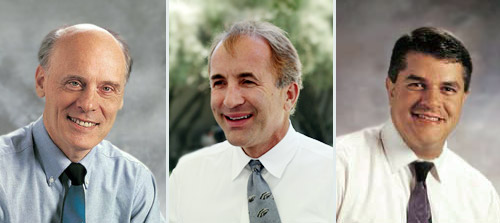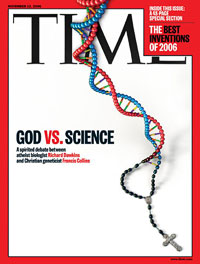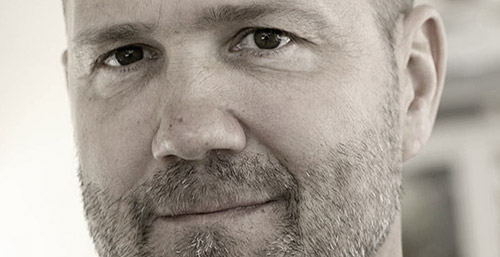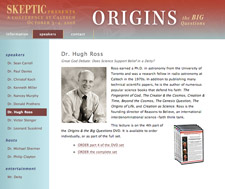In this week’s eSkeptic, Gary J. Whittenberger shares his analysis of the debate between Michael Shermer and Hugh Ross/Fazale Rana, on whether or not creationism can be a testable science.
Gary Whittenberger is a free-lance writer and psychologist, living in Tallahassee, Florida. He received his doctoral degree from Florida State University after which he worked for 23 years as a psychologist in prisons. He has published many articles on science, philosophy, psychology, and religion, and their intersection.

left to right: Hugh Ross, Michael Shermer, and Fazale Rana debated whether or not creationism can be a testable science
“Reasons To Believe” … or Not
by Gary J. Whittenberger
On February 25, 2009, I attended a debate between Dr. Michael Shermer of Skeptic magazine and Dr. Hugh Ross and Dr. Fazale Rana of Reasons to Believe, a Christian apologetics organization that attempts to reconcile the findings of science and with the tenets of faith. The event was held at the University of North Florida in Jacksonville.
Dr. Ross opened with a 25-minute explanation and defense of the RTB (Reasons To Believe) Testable Creation Model of the Universe and focused primarily on cosmology and physics. His talk was followed by a 25-minute presentation by Dr. Rana, who focused on the chemical and biological aspects of the model. Then for about 40 minutes, Shermer offered a general overview of skepticism and an incisive critique of the RTB model. This was followed by a Q&A session among the three panelists and then by a general audience Q&A session. Some levity was brought to the event during the Q&A by a drawing for door prizes by someone dressed in a gorilla costume. The gorilla gave away t-shirts, a skateboard, and even a flat-panel TV set, and fun was had by all!
Ross began by saying that scientists had finally and certainly determined that space, time, and matter-energy all began at the moment of the Big Bang. He didn’t bother to mention that although this is a favored idea by many scientists, there are other respected cosmologists and physicists, such as Paul Steinhardt and Neil Turok, who contend that time had no beginning and is endless (see their 2007 book Endless Universe: Beyond the Big Bang, Doubleday). Nevertheless, defending his own model of the universe, Ross asserted that God caused the beginning of time at the moment of the Big Bang. As other Creationists often do, Ross seems to ignore the fact that an act of a person causing something is itself an event in time, and so he backs himself into the corner of contradiction by implying there was time before the beginning of time. Of course this makes no sense, but Ross is unfazed; he simply imagines that there is a supernatural time and a natural time and supposes that this solves everything.
Ross and his RTB associates are fond of the hypothesis of the fine-tuning of the universe, which is the modern-day resurrection of the design argument, which goes something like this:
- If things had been different, then things would be different.
- If the physical constants of the universe had been different at the Big Bang, then we wouldn’t have life, especially human life, today.
- The physical constants could have been different and all their exact values are, individually and taken together, extremely improbable.
- Therefore, God exists because somebody was required to select those exact values of the constants for the purpose of getting humans later on.

The first two premises are reasonable, but the third is uncertain and the conclusion does not follow. I provided a more detailed discussion of this flawed fine-tuning argument in a 2007 issue of Skeptic (Whittenberger, Gary J. The Dawkins v. Collins Debate: A skeptical analysis of the Time magazine debate between Richard Dawkins and Francis Collins, Vol. 13, No. 2), but I want to point out what I think is another common flaw that I didn’t mention there.
Ross and his cohorts first identify all the factors that had to be just right for life and/or humans to exist on Earth (he now says there are hundreds), they then calculate the low probability for each, and then they compute the extremely low probability of all these factors occurring at the same time or in succession. They perform this last step by the multiplication of probabilities. It’s rather similar to calculating the probability of getting ten heads in a row from ten flips of a coin. In this instance you merely take the probability of getting a head on one flip (.5), multiply ten of these together, and get approximately .000977 as the probability of getting ten heads in a row. In a similar manner, Ross takes the individual probabilities of different physical constants being favorable for the existence of humans, multiplies these hundreds of probabilities together, and gets an extremely low probability that all of these physical constants would all happen to be just right for life and intelligent human life. Obviously, an intelligent fine-tuner would be needed to cause this to happen, and sure enough, Ross finds him in the Bible.
But Ross and others are not justified in multiplying the probabilities because, unlike in our coin-flipping example where we correctly assume the independence of separate coin flips, they don’t know that the individual physical constants of the universe are independent of one another. It could be that these constants, if they could be different from what they are, are totally dependent on one another. Perhaps if one constant takes on one particular value, then the others must take on particular values through some natural law. At this point in our knowledge, we just don’t know the relative degree of independence/dependence of these physical factors, and so Ross is not justified in thinking that he does know and that he can simply multiply the relevant probabilities together.
Ross and Rana proudly asserted that their RTB model makes predictions, like any good scientific model should. But some of the predictions that they presented at the debate were not very impressive. Ross claimed that he had used the model several years ago to accurately predict that science would discover more and more finely-tuned physical constants that could only have been produced by a majestic fine-tuner, and he claimed that this prediction will continue to be fulfilled. All this really means is that persons who wish to believe in God, especially physicists, will continue to pick out factors and constants whose values they assert could have been different, are very improbable, and must have been selected by an Intelligent Design or God for a noble purpose — the eventual creation of human beings. Now, there is a prediction you can take to the bank!
In a clever maneuver via one of his slides, Shermer posed to his opponents a set of questions prepared for him by Sean M. Carroll, a well-regarded cosmologist and astrophysicist from Caltech (see his technical book Spacetime and Geometry: An Introduction to General Relativity, published by Benjamin Cummings). These were questions mainly about cosmology, astronomy, and physics to which science currently has no answers. Shermer asked Ross and Rana to make predictions from their RTB model about the answers to these questions; they provided none. I’m not going to hold my breath waiting, but if Ross finally provides the requested predictions, maybe we can actually calculate his rate of hits and misses over the next couple of decades. Here are Carroll’s questions for Ross to answer:
- What is making the universe accelerate? Cosmological constant, quintessence, modified gravity?
- What is the dark matter? Is there only one kind?
- What is the mass of the Higgs? Is there only one Higgs?
- Are there large extra dimensions of space?
- Did inflation happen? At what energy? Will we see its imprint in gravitational waves on the microwave background?
- Is supersymmetry right? Is string theory?
- Explain something the Bible predicts that hasn’t yet be found and will be completely surprising when it is.
Almost all arguments for the existence of God are based on analogies to human performance. For ancient humans the analogy was this: Humans move objects, objects in nature move, and so these objects must be moved by an invisible intelligence or designer. For the 19th century theologian William Paley, the analogy was this: Humans make watches which are complex, objects in nature are complex, and so objects in nature must have been made by an invisible intelligence or designer. For Ross the analogy is this: Humans fine-tune their machines for a purpose, values of the universe’s physical constants are extremely improbable but consistent with the existence of human life, therefore the universe must have been finely-tuned by a hidden super intelligent agent for the purpose of producing humans.
During his presentation, Fuz Rana continued this grand tradition of arguing for God through analogy by focusing on DNA. His analogy goes something like this: Humans create languages with orderly hierarchical structures, DNA has an orderly hierarchical structure, therefore DNA must have been created by an invisible designer. Rana said that a polypeptide is like a word, and thus somebody “out there” must have intended to produce that polypeptide just like humans on Earth intend to produce words to have certain meanings. However, apparently oblivious to the limits of the analogy, Rana fails to recognize that words symbolize (stand in the place of) concepts, whereas polypeptides do not symbolize anything; instead they produce chain reactions. Rana generalized his language analogy by talking about information and codes.
During the debate Ross cited Bible verses to demonstrate how the model of the universe derived from God’s Word exactly matches the model of the universe developed by scientists. Shermer pointed out that because he, Ross, knows the science, he is able to go back to the Bible and cherry-pick passages from it to fit the science. Of course, Ross denied this. When Ross is confronted with passages from the holy book that don’t seem to fit the science, he reverts to the usual “not everything is literal” defense, or goes into a long-winded monologue on the etymology of Greek and Hebrew words.
As I listened to Ross and Rana, I was reminded of Shermer’s investigations of mediums, palm and tarot card readers, and other psychics. They all seem to be playing the same game — the game of “Search for a Match Because You Really Want to Find It.” A medium will provide a vague piece of information, allegedly received from a dead loved one, to a subject who, wanting to believe that their dead loved one is living happily ever after and will be available for meet-ups later on, will search for a match of the information from the medium to anything in the known history of the loved one. And of course, the subject will almost always find a match, regardless of how tenuous or peripheral, because he/she really wants to find it. Ross does the same thing, taking a piece of information from the Bible and searching for a match in science, and he inevitably finds one because he really wants to find it! At other times, he will take a piece of information from science and search for a match in the Bible, and of course, he nearly always finds one, even if he has to do some contortions with words. His own wishes and hopes (and probably prayers) that the Bible and science are perfectly compatible, that God exists, and all is well with the world (at least for Christians) drives him to play the game.
One thing I noticed at the debate and at the Skeptics’ conference on Origins last October, is that Ross has really good slides. Shermer has good slides too, but not nearly as good as Ross’s. Ross’s slides are the best I have ever seen and they are likely to influence the naive, the uneducated, the wishful thinkers, and those unmotivated to dig below the surface. I guess it just goes to show that even a dead man will look good if you dress him up in a tuxedo and you don’t look too closely. We need to dig below the surface, to go beyond the fancy slides, as Shermer did at the debate. Eventually somebody will need to read all of Ross’s books and provide a comprehensive critique of his RTB model; this project itself will require an entire book. It seems to me that such a critique could proceed in two steps. The first step would be to show how the model fails on scientific and philosophical grounds, regardless of its origin, i.e. whether or not it came from the Bible. The second step would be to show how, in a comprehensive and not cherry-picking way, the model does not match up well with the Bible. The first step would seem to be the more important step, for if the model is fatally flawed scientifically and philosophically, which it seems to be, who would really care if it matched up well with the Bible or not?

Our Next Lecture at Caltech:
Losing My Religion
with William Lobdell
Sunday, March 22, 2009 at 2:00 pm
Baxter Lecture Hall, Caltech (map)












